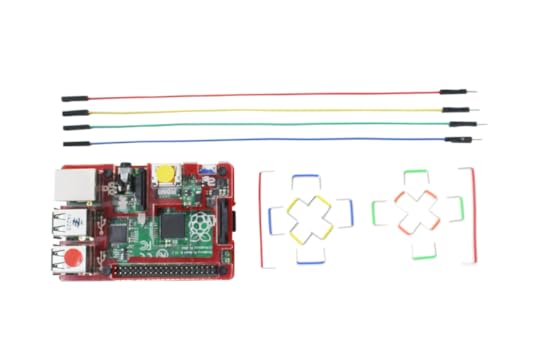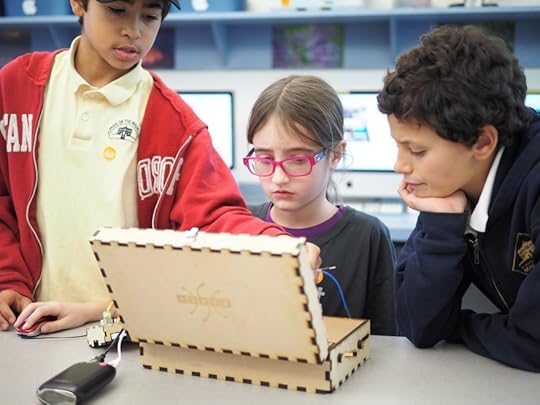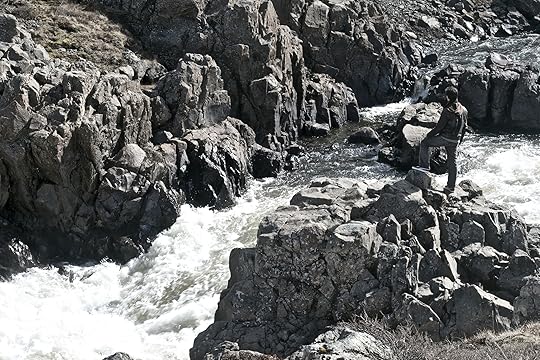Kill Screen Magazine's Blog, page 283
March 10, 2015
In Direction, all breakups are nightmarish
Why doesn't it work out?
Prowl constructs a haunting vignette out of slow, dark jazz
It's all about soul.
A video game convention for the LGBT community widens its scope
GX3 proclaims that “everyone games.”
Skeletal Dance Simulator is the cutest way to shake your bones
Who knew a skeleton party would be exactly what you needed today?
Can't you feel spring coming in your bones? Celebrate with Skeletal Dance Simulator.
A philosophical history of the “Press Start” screen
The beginning of the one-button reality.
March 9, 2015
The makers of Monument Valley want to fix your dashboard
How to gauge your interest?
Piper brings the playability of Minecraft to computer engineering
Recently, I helped (let's be honest, mostly watched) someone build a PC for the first time.
Now, I'm not exactly what you'd call a "tech-savy" person—by which I mean computers scare the living daylights out of me. They're just so daunting: their finickiness and delicacy, the mountains of information needed to keep up-to-date with the tech, having to learn an entirely new language to communicate in. Let's just say that trying to get into computer engineering is not what one might call "user-friendly" (am I using that right?)
we'll need a generation of kids unintimidated by [technology's] complexity
But actually watching computer engineering happen? That's magical, pure and simple. The first time you crack open a computer case to catch glimpse of the motherboard, it's like gazing into a miniature alien city. Blinking lights and four-inch skyscrapers light up the eternal darkness the motherboard lives in. You can't believe that everything this machine is capable of comes down to an orderly layout of strings and LEGO pieces.
 I probably don't have to convince you of the beauty of technology. But if it's taken me this long—a person technically working in a field of technology—to have a hands-on experience with computer engineering's beauty, then we've got a problem. Because the more integrated we become with technology, the more that alien city making your computer work will also become responsible for making our real world cities work. And, to continue improving on a world built with technology, we'll need a generation of kids unintimidated by its complexity.
I probably don't have to convince you of the beauty of technology. But if it's taken me this long—a person technically working in a field of technology—to have a hands-on experience with computer engineering's beauty, then we've got a problem. Because the more integrated we become with technology, the more that alien city making your computer work will also become responsible for making our real world cities work. And, to continue improving on a world built with technology, we'll need a generation of kids unintimidated by its complexity.
Which is where the Piper toolbox comes in.
"We believe that when you use electronics straight out of the box, you don't really own it or understand it," the Kickstarter campaign says. "Somebody else made it for you to consume, so we wanted Piper to be different."
In simplified terms, the Piper toolbox provides that mesmerizing hands-on experience with computer engineering that too many people miss. Specifically, for kids in the throes of developing hobbies that can eventually turn into career paths. Knowing that our future relies on kids understanding the tools they use day-in and day-out, the Piper teams wants "kids to look at technology and be able to deconstruct it and reconstruct it in a way that can be better, more efficient, and really innovative to improve the world."
Here's how it works: you assemble your own wooden box with an LED screen, powerpack, and mouse, along with a Raspberry Pi 2 Linux board for all the electronics. You build everything from the ground-up, including the controller you use to interact with the modified Minecraft level. In the philosophy of LEGO, no instruction manual is needed.
"Low floor, high ceiling, wide walls."
The premise of the Minecraft level revolves around a robot that's sent to an unknown planet. You control the robot from mission control, so when it takes damage upon arrival, you must both repair it and help carry out the mission goals. Each challenge requires you to physically build new hardware in the Piper toolbox, which corresponds to an on-screen schematic.
For example, installing and turning on switches can open doors. Dark areas that are ripe for diamond-hunting requires LED light proximity censors. The electronics can be combined in all sorts of different ways, allowing you overcome all sorts of challenges with your own unique solution. And while there are set levels, the teams says "we want you to invent things we didn’t even think of, so we are using completely off-the-shelf hardware and electronics so that you can add literally any electronics components in existence to build your own cool power-ups!"

Piper provides a system that's simultaneously easy to understand and expand on. While designing the learning platform, they adopted the principles that MIT's Mitchel Resnick describes as "low floor, high ceiling, wide walls." Removing all barriers was a top priority, along with creating an Open Source tool to allow these budding engineers a reason to collaborate online, while getting feedback on their experiments in realtime on through a Minecraft game loop.
There's lots of personal testimonials vouching for Piper from teachers, principals and even vice president of games at Zynga, Maureen Fan. But the testimonial that matters most to the Piper team is from the minds they're trying to inspire. "The kids we worked with became a lot more confident about themselves as creators and builders," they say on the Kickstarter. "It doesn't take a lot to inspire a child to believe in herself. And we want Piper to be the first step. To give today's kids a relevant and fun way to become the inventors of tomorrow."
Though Piper has already surpassed its funding goal, the team will continue to add stretch goals in the remaining weeks of the campaign. Get your own Piper toolbox here!
Valve/HTC’s Vive is the “Narnia closet stuck to your face”
Walking around in virtual reality.
The Isolation Game Jam finds inspiration in nothingness
Header photo by Horatiu Roman.
///
The farm is set into a dead-end valley. It has walls composed of old grey stonework, a single tractor, sometimes there are lambs. There isn't much else, except the endless grey beard of the sky above, its ubiquity matched only by the hay-swathed terrain below it. Here, in this desolation, close to the highland border of north-west Iceland, the closest town about 30 kilometers away, is where the Isolation Game Jam is held.
there are only mountains, tundras, and glaciers for company
"The best word to describe the area is bleak, and I do not mean that in a bad way," says Jóhannes Gunnar Þorsteinsson. He's the organizer and host of the Isolation Game Jam. He also founded Leikjasamsuðan (The Icelandic Game Assembly) to unite fellow Icelandic videogame creators, and introduce the art to other locals who were oblivious to it.
Þorsteinsson lives on Fosshóll farm in Vesturárdalur, which is right next to Kollafoss, the farm where the Isolation Game Jam took place for the first time on April 25th 2014. He didn't believe that seven people from as far as Romania, Sweden, Finland, Iceland, and Canada would travel specifically to his remote realm of the world, and only to make videogames and "interactive experiences" for a few days. It sunk in once they dropped their bags on the doorstep.

(Photo taken by Horatiu Roman)
This was the result of a joke he had made some months earlier at the Exile Game Jam 2013 in Denmark. The idea of that jam is to be a cosier experience than the much larger Nordic Game Jam in Copenhagen. It's hosted far away from the ruckus of the capital city, "in a small town with asphalt roads, and with a grocery store a 20 minute walk from the venue," as Þorsteinsson remembers it. As he turned up, he boasted that if detachment was the aim then he could do much better—there was civilization there, where he lived there are only mountains, tundras, and glaciers for company.
There is only capacity for eight to ten people to participate in the Isolation Game Jam. They each pay 5500 Icelandic kronur (about $40) to stay at the farmhouse for the jam's duration (bed linen, towels, and such are all included). Shopping for food is done only once, in bulk, right at the start of the jam as the nearest grocery store is 30 km away, and there's no public transportation.

("Abstract Forest" by Minnamari Helmisaari and Karl Bergendahl)
Unlike other game jams, at the heart of the Isolation Game Jam is absorbing the stretches of land beginning at your feet and spreading across the volcanic rocks, up to the highlands, and sinking into the cold coast. It's from this barren topography that you draw your inspiration—Minnamari Helmisaari and Karl Bergendahl's entry to the 2014 jam, "Abstract Forest," captures the magnitude of the landscape in an abstract 3D rendition. "[T]he silence and emptiness was what affected last year's guests the most," says Þorsteinsson.
"sitting outside enjoying the nothingness"
To experience the hulking terrain, each morning after breakfast, the group that formed last year's participants ventured outdoors, climbing balky ancient rocks, seeing newborn lambs, and feeling the fresh chill against their cheeks. One day they took a trip up to a nearby volcanic lava tap in the district. After returning to lunch, they would begin work for the day, pushing out everything they had felt in the morning through their creative glands. If anyone needed a break or a refresher, they could go for a short walk, "simply sitting outside enjoying the nothingness," says Þorsteinsson.
Work would typically cease at about 6pm, at which point they all stopped to prepare a hearty feast—one day having a traditional Icelandic meat soup so as to be further absorbed in the local culture. Work may have continued after this, or it may have spiralled into chats, drinks, and piercing each other with arrows in TowerFall.

(Photo taken by Jóhannes Gunnar Þorsteinsson)
After the success of the first Isolation Game Jam, Þorsteinsson has decided to hold another one this year, at the same location. The date has been moved back to May 28th this time, lasting until June 1st. He has also prepared a full schedule for everyone as a guideline (it's still very much free-form), to make it more of a rounded experience for anyone who wants that, rather than a spur of the moment get-together. Meals have been given a time for every day, there's a secret trip, and space is allocated to "enjoy the silence and near complete lack of human civilization."
"As an extra bonus, this year's Isolation Game Jam will be hosted in the latter end of the lambing season, which means people will be able to pet and hug lambs," Þorsteinsson says. Do you really need to know anything more than that? It's a rare opportunity to be among gorgeous empty vistas barely touched by our far-reaching cultures. If you're quick, you could go there to have everything north-west Iceland has to offer flow through your system, all in order to output it as a succinct interactive experience.
Find out more about the Isolation Game Jam on its website.
LucasArts and the rationalist tendency in videogames
The legacy of Grim Fandango is broader than you think.
Kill Screen Magazine's Blog
- Kill Screen Magazine's profile
- 4 followers



